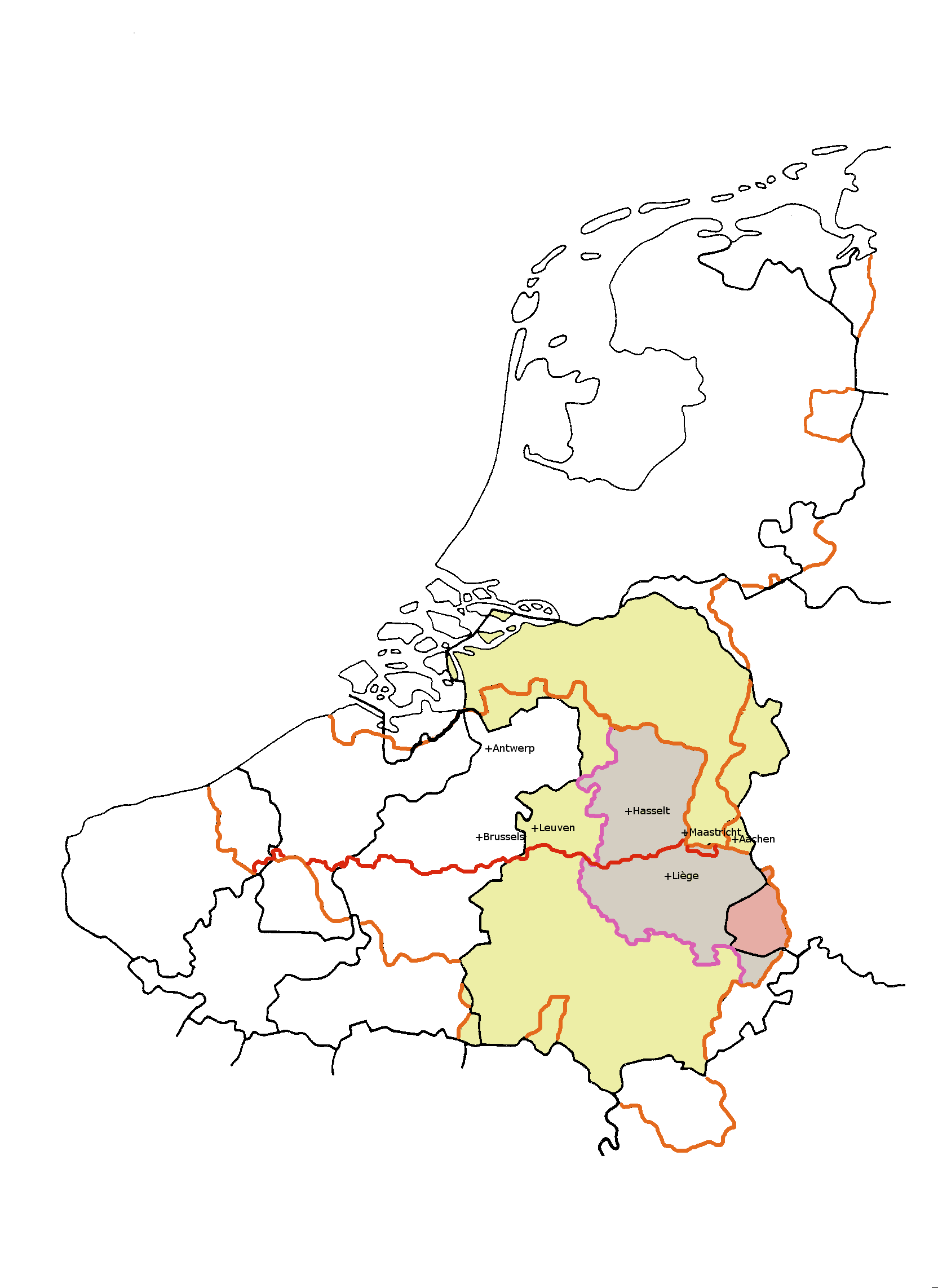|
Vihansa
Vihansa is the name of a Germanic goddess written on a bronze tablet found in Sint-Huibrechts-Hern, near Tongeren in modern Belgium. Name There is general agreement among scholars that the theonym is Germanic; it probably belongs to the Tungrian dialect or language. ''Vihansa'' is most likely a Latinized form of the compound *''wiha-ansu''-, meaning 'holy deity'. Dedication The inscription was engraved by Q. Catius Libo Nepos, centurion with Legio III Cyrenaica Legio III Cyrenaica, ( Third Legion " Cyrenean") was a legion of the Imperial Roman army. The legion had its origins among the forces of Mark Antony during the civil wars of late first century BC. In the Imperial period it was stationed in Egyp ..., who dedicated his shield and spear to the goddess Vihansa, probably after returning to his homeland from a military service: Marie-Thérèse Raepsaet-Charlier supposes she must have been a warrior deity due to the martial offering mentioned in the inscription.Ra ... [...More Info...] [...Related Items...] OR: [Wikipedia] [Google] [Baidu] |
Tungri
The Tungri (or Tongri, or Tungrians) were a tribe, or group of tribes, who lived in the Belgic part of Gaul, during the times of the Roman Empire. Within the Roman Empire, their territory was called the '' Civitas Tungrorum''. They were described by Tacitus as being the same people who were first called "''Germani''" ( Germanic), meaning that all other tribes who were later referred to this way, including those in Germania east of the river Rhine, were named after them. More specifically, Tacitus was thereby equating the Tungri with the "''Germani Cisrhenani''" described generations earlier by Julius Caesar. Their name is the source of several place names in Belgium, Germany and the Netherlands, including Tongeren, Tongerlo Abbey, and Tongelre. image:Germanie-inferieure.jpg, 301x301px, The Roman province of Germania Inferior, showing Atuatuca, modern Tongeren, the capital of the Tungri (Tongres). Places associated with the Tungri are in bright green. It was on the road between Ami ... [...More Info...] [...Related Items...] OR: [Wikipedia] [Google] [Baidu] |
Germanic Paganism
Germanic paganism or Germanic religion refers to the traditional, culturally significant religion of the Germanic peoples. With a chronological range of at least one thousand years in an area covering Scandinavia, the British Isles, modern Germany, and at times other parts of Europe, the beliefs and practices of Germanic paganism varied. Scholars typically assume some degree of continuity between Roman-era beliefs and those found in Norse paganism, as well as between Germanic religion and reconstructed Indo-European religion and post-conversion folklore, though the precise degree and details of this continuity are subjects of debate. Germanic religion was influenced by neighboring cultures, including that of the Celts, the Romans, and, later, by Christian religion. Very few sources exist that were written by pagan adherents themselves; instead, most were written by outsiders and can thus can present problems for reconstructing authentic Germanic beliefs and practices. Some bas ... [...More Info...] [...Related Items...] OR: [Wikipedia] [Google] [Baidu] |
Tongeren
Tongeren (; french: Tongres ; german: Tongern ; li, Tóngere ) is a city and municipality located in the Belgian province of Limburg, in the southeastern corner of the Flemish region of Belgium. Tongeren is the oldest town in Belgium, as the only Roman administrative capital within the country's borders. As a Roman city, it was inhabited by the Tungri, and known as ''Atuatuca Tungrorum'', it was the administrative centre of the ''Civitas Tungrorum'' district. History ''Atuatuca Tungrorum'' The Romans referred to Tongeren as ''Aduatuca Tungrorum'' or ''Atuatuca Tongrorum'', and it was the capital of the large Roman province of '' Civitas Tungrorum'', an area which covered modern Belgian Limburg, and at least parts of all the areas around it. Before the Roman conquests, this area was inhabited by the group of Belgic tribes known as the '' Germani cisrhenani''. (Despite being known as the ''Germani'', whether they spoke a Germanic language is debated, and the names of their tr ... [...More Info...] [...Related Items...] OR: [Wikipedia] [Google] [Baidu] |
Belgium
Belgium, ; french: Belgique ; german: Belgien officially the Kingdom of Belgium, is a country in Northwestern Europe. The country is bordered by the Netherlands to the north, Germany to the east, Luxembourg to the southeast, France to the southwest, and the North Sea to the northwest. It covers an area of and has a population of more than 11.5 million, making it the 22nd most densely populated country in the world and the 6th most densely populated country in Europe, with a density of . Belgium is part of an area known as the Low Countries, historically a somewhat larger region than the Benelux group of states, as it also included parts of northern France. The capital and largest city is Brussels; other major cities are Antwerp, Ghent, Charleroi, Liège, Bruges, Namur, and Leuven. Belgium is a sovereign state and a federal constitutional monarchy with a parliamentary system. Its institutional organization is complex and is structured on both regional ... [...More Info...] [...Related Items...] OR: [Wikipedia] [Google] [Baidu] |
Theonym
A theonym (from Greek ''theos'' (Θεός), "god"'','' attached to ''onoma'' (ὄνομα), "name") is the proper name of a deity. Theonymy, the study of divine proper names, is a branch of onomastics (the study of the etymology, history, and use of proper names.); it helps develop an understanding of the function and societal views of particular gods and may help understand the origins of a society's language. Analysis of theonyms has been useful in understanding the connections of Indo-European languages, and possibly their religion. In all languages, the analysis of the possible etymological origin of a theonym can serve as basis for theories of its historical origin. Metaphysical and mystical meanings are also discerned in theonyms, as in Kabbalah. Theonyms can also appear as all or part of a name for a human, animal, thing or place. See also * -onym * Theo * Theology * Thealogy, similar origin as above, but female instead * God (word) * Names of God * Nomenclature ... [...More Info...] [...Related Items...] OR: [Wikipedia] [Google] [Baidu] |
Germanic Languages
The Germanic languages are a branch of the Indo-European language family spoken natively by a population of about 515 million people mainly in Europe, North America, Oceania and Southern Africa. The most widely spoken Germanic language, English, is also the world's most widely spoken language with an estimated 2 billion speakers. All Germanic languages are derived from Proto-Germanic, spoken in Iron Age Scandinavia. The West Germanic languages include the three most widely spoken Germanic languages: English with around 360–400 million native speakers; German, with over 100 million native speakers; and Dutch, with 24 million native speakers. Other West Germanic languages include Afrikaans, an offshoot of Dutch, with over 7.1 million native speakers; Low German, considered a separate collection of unstandardized dialects, with roughly 4.35–7.15 million native speakers and probably 6.7–10 million people who can understand it [...More Info...] [...Related Items...] OR: [Wikipedia] [Google] [Baidu] |
Compound (linguistics)
In linguistics, a compound is a lexeme (less precisely, a word or sign) that consists of more than one stem. Compounding, composition or nominal composition is the process of word formation that creates compound lexemes. Compounding occurs when two or more words or signs are joined to make a longer word or sign. A compound that uses a space rather than a hyphen or concatenation is called an open compound or a spaced compound; the alternative is a closed compound. The meaning of the compound may be similar to or different from the meaning of its components in isolation. The component stems of a compound may be of the same part of speech—as in the case of the English word ''footpath'', composed of the two nouns ''foot'' and ''path''—or they may belong to different parts of speech, as in the case of the English word ''blackbird'', composed of the adjective ''black'' and the noun ''bird''. With very few exceptions, English compound words are stressed on their first compo ... [...More Info...] [...Related Items...] OR: [Wikipedia] [Google] [Baidu] |
Legio III Cyrenaica
Legio III Cyrenaica, ( Third Legion " Cyrenean") was a legion of the Imperial Roman army. The legion had its origins among the forces of Mark Antony during the civil wars of late first century BC. In the Imperial period it was stationed in Egypt, where it played a key role in campaigns against the Nubians and Jews. In the first century AD, it was usually located in Arabia Petraea. There are still records of the legion in Syria at the beginning of the 5th century. The legion symbol is unknown. History Origins and service in Egypt The origins of the legion are unclear, but it is first attested as part of Mark Antony's forces during the period of the Second Triumvirate (43-33 BC). Cyrenaica was under the control of Marcus Aemilius Lepidus before 36 BC and of Mark Antony after that date; either of them might have established the Legio III. Pollard and Berry suggest that the legion was established by Lucius Pinarius Scarpus, an ally of Mark Antony who was his governor of Cyre ... [...More Info...] [...Related Items...] OR: [Wikipedia] [Google] [Baidu] |
Corpus Inscriptionum Latinarum
The ''Corpus Inscriptionum Latinarum'' (''CIL'') is a comprehensive collection of ancient Latin inscriptions. It forms an authoritative source for documenting the surviving epigraphy of classical antiquity. Public and personal inscriptions throw light on all aspects of Roman life and history. The ''Corpus'' continues to be updated in new editions and supplements. CIL also refers to the organization within the Berlin-Brandenburg Academy of Sciences and Humanities responsible for collecting data on and publishing the Latin inscriptions. It was founded in 1853 by Theodor Mommsen and is the first and major organization aiming at a comprehensive survey. Aim The ''CIL'' collects all Latin inscriptions from the whole territory of the Roman Empire, ordering them geographically and systematically. The earlier volumes collected and published authoritative versions of all inscriptions known at the time—most of these had been previously published in a wide range of publications. The ... [...More Info...] [...Related Items...] OR: [Wikipedia] [Google] [Baidu] |
Germanic Goddesses
Germanic may refer to: * Germanic peoples, an ethno-linguistic group identified by their use of the Germanic languages ** List of ancient Germanic peoples and tribes * Germanic languages :* Proto-Germanic language, a reconstructed proto-language of all the Germanic languages * Germanic name * Germanic mythology, myths associated with Germanic paganism * Germanic religion (other) * SS ''Germanic'' (1874), a White Star Line steamship See also * Germania (other) * Germanus (other) * German (other) * Germanicia Caesarea Marash (Armenian: Մարաշ), officially Kahramanmaraş () and historically Germanicea (Greek: Γερμανίκεια), is a city in the Mediterranean Region of Turkey and the administrative center of Kahramanmaraş Province. Before 1973, Kahra ... * * {{disambiguation Language and nationality disambiguation pages ... [...More Info...] [...Related Items...] OR: [Wikipedia] [Google] [Baidu] |
Latin Inscriptions
The ''Corpus Inscriptionum Latinarum'' (''CIL'') is a comprehensive collection of ancient Latin inscriptions. It forms an authoritative source for documenting the surviving epigraphy of classical antiquity. Public and personal inscriptions throw light on all aspects of Roman life and history. The ''Corpus'' continues to be updated in new editions and supplements. CIL also refers to the organization within the Berlin-Brandenburg Academy of Sciences and Humanities responsible for collecting data on and publishing the Latin inscriptions. It was founded in 1853 by Theodor Mommsen and is the first and major organization aiming at a comprehensive survey. Aim The ''CIL'' collects all Latin inscriptions from the whole territory of the Roman Empire, ordering them geographically and systematically. The earlier volumes collected and published authoritative versions of all inscriptions known at the time—most of these had been previously published in a wide range of publications. The descr ... [...More Info...] [...Related Items...] OR: [Wikipedia] [Google] [Baidu] |

.jpg)

